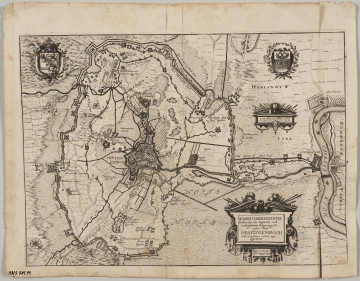
Plan of the fortifications of Szczecin with Fort Prussia
1734-03-07
National Museum in Szczecin
Part of the collection: European classics of modernity
January Suchodolski came from a Polish noble family settled in the estate of Rohoźnica in Lithuania (today Belarus). From 1810, he studied at the Cadet Corps of the Elementary Artillery and Engineer School of the Army of the Duchy of Warsaw, where he began a course in drawing. From 1823, becoming the adjutant of general Wincenty Krasiński, he gained access to his artistic and military collections. He debuted at the Public Exhibition of Works of Fine Arts in 1825 (Warsaw University), presenting Orientalist canvases Śmierć Władysława pod Warną [The Death of Władysław at Varna] and Wzięcie sztandaru Mahometa pod Wiedniem [Taking the Banner of Muhammad at Vienna]. In 1830, he participated in the November Uprising, and after its fall decided to devote himself entirely to painting. In 1832 Suchodolski went to Rome, where, recommended by Napoleon II Bonaparte, he took up studies at the French Academy run by Horace Vernet, a battle painter and orientalist admired for years. One of the most important orders coming from Poland was from Edward Raczyński, completing the furnishings of the Chapel of Polish Kings at the cathedral in Poznań (Mieczysław I kruszy bałwany [Mieczysław I Crushes Idols], 1837). His return to Warsaw in 1837 began two decades of the artist's greatest prosperity. Commissioned by Nicholas I, Suchodolski painted a view of the besieged fortress of oczakow, which decorated the interior of the Winter Palace on the banks of the river. The scene shows the capture of the Turkish city by the Russians, resulting in the incorporation of the lands between the Dniester, Bohemia and Kodyma into the Romanov Empire. The Szczecin version of the painting differs from the St Petersburg work in its smaller format and more simplified staffage. In the centre of both compositions there is a shot dark-skinned warrior who, sliding down from the back of a climbing grey steed, accentuates the moment of the defeat of Islam by the Western world. The great role that Russia ascribed to itself in this process is evidenced by the glorification of the victory at Oczakow in the famous ode by Gavrilo Dzerzhavin (1788) and Giuseppe Sarti's Te Deum (1789).
Szymon Piotr Kubiak
Author / creator
Dimensions
cały obiekt: height: 50 cm, width: 73 cm
Object type
painting
Creation time / dating
Creation / finding place
Identification number
Location / status

1734-03-07
National Museum in Szczecin

1629 — 1639
National Museum in Szczecin

1807
National Museum in Szczecin
DISCOVER this TOPIC
Museum of King Jan III's Palace at Wilanów
DISCOVER this PATH
Educational path